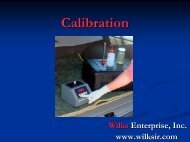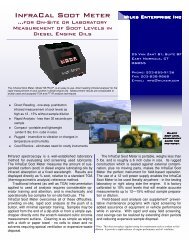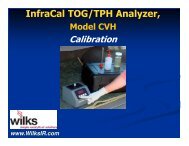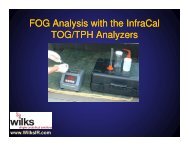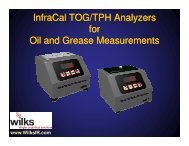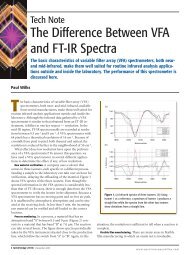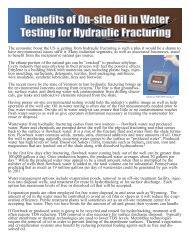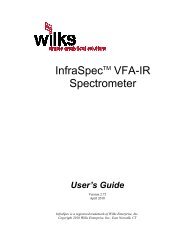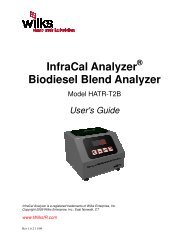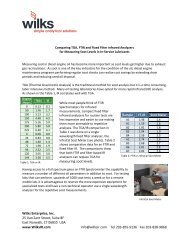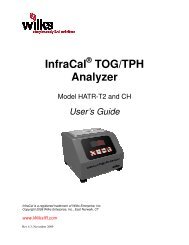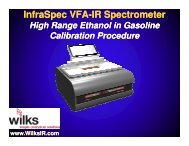Antioxidant in Transformer Oil Measurment - Wilks Enterprise, Inc.
Antioxidant in Transformer Oil Measurment - Wilks Enterprise, Inc.
Antioxidant in Transformer Oil Measurment - Wilks Enterprise, Inc.
You also want an ePaper? Increase the reach of your titles
YUMPU automatically turns print PDFs into web optimized ePapers that Google loves.
DBPC Concentration Wt<br />
%<br />
DBPC Inhibitor <strong>in</strong> <strong>in</strong> <strong>Oil</strong> as a Function<br />
of Concentration<br />
0.600<br />
0.500<br />
0.400<br />
0.300<br />
0.200<br />
0.100<br />
0.000<br />
0.100<br />
0.000 0.100 0.200 0.300<br />
Absorbance (A)<br />
Graph 3<br />
SDM Wt % Sealed<br />
Cell 0.5 mm<br />
Laboratory A Wt %<br />
Sealed cell 1 mm<br />
<strong>Wilks</strong> InfraCal Wt %<br />
Sealed cell 1<br />
mm<br />
Regression Trend L<strong>in</strong>e<br />
Another method for DBPC or DBP <strong>in</strong>hibitor determ<strong>in</strong>ation is given <strong>in</strong> ASTM D 4768 5 and is performed<br />
by Gas Chromatography (GC) us<strong>in</strong>g a solvent solution and an FID detector. The analysis time with<br />
sample and standard preparation is one to two days <strong>in</strong> length. The method also requires the use of<br />
flammable solvents and runn<strong>in</strong>g five standards on the <strong>in</strong>strument before the sample is prepared and<br />
run. The proposed portable IR method requires one standard of 100 ml, which can be stored up to 6<br />
months or longer under refrigeration. S<strong>in</strong>ce the portable <strong>in</strong>strument used only about one to two ml for<br />
the calibration, the standard does not have to be prepared for each analysis. The disposal of the waste<br />
material is simplified without the flammable solvent and the relatively small volume of waste oil after the<br />
test is completed.<br />
Conclusion<br />
The portable <strong>in</strong>frared analyzer <strong>in</strong>strument gave a good representation of the <strong>in</strong>hibitor DBPC <strong>in</strong> the<br />
m<strong>in</strong>eral oil dielectric fluid used <strong>in</strong> electrical equipment over the range of the experiment of 0.0 to 0.55<br />
weight percent. This range of <strong>in</strong>hibitor has been studied and has been determ<strong>in</strong>ed that 0.3 % is the<br />
optimum amount for the purpose of prolong<strong>in</strong>g transformer life 2 . Any more of this chemical <strong>in</strong> the<br />
dielectric fluid does not seem to offer any improved protection to the system and may actually cause<br />
some detrimental affect <strong>in</strong> the transformer 1 . The portability of the <strong>in</strong>frared analyzer <strong>in</strong>strument can be a<br />
real convenience, especially when an electrical outlet is not available for <strong>in</strong>strument connection. The<br />
analysis of the <strong>in</strong>hibitor can be carried out <strong>in</strong> less than one m<strong>in</strong>ute and can be performed by an operator<br />
with m<strong>in</strong>imal tra<strong>in</strong><strong>in</strong>g. This portability allows for the immediate sampl<strong>in</strong>g and test<strong>in</strong>g of the sample<br />
without the need to draw and transport it to a remote laboratory. The portable unit would generate a<br />
relatively small volume of test oil that can be carried with the field crew until a convenient time for<br />
disposal.



